Consumer Price Index, September 2012
Archived Content
Information identified as archived is provided for reference, research or recordkeeping purposes. It is not subject to the Government of Canada Web Standards and has not been altered or updated since it was archived. Please "contact us" to request a format other than those available.
Related subjects
-
[an error occurred while processing this directive]
Consumer prices rose 1.2% in the 12 months to September, matching the increase in August. Higher energy prices, particularly for gasoline and electricity, led the advance in the Consumer Price Index (CPI) for September. This was tempered by lower year-over-year price increases for the purchase of passenger vehicles and for food purchased from stores.
Energy prices
Energy prices advanced 2.9% in the 12 months to September after rising 0.8% in August.
The 12-month change in the energy index
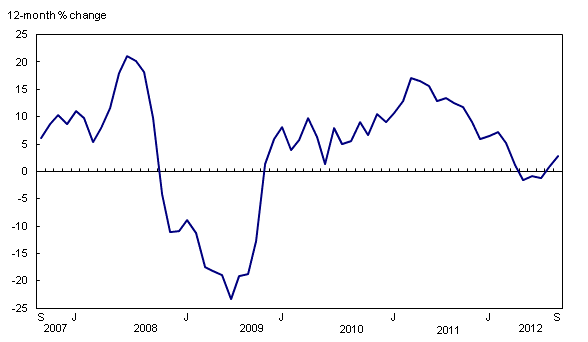
Chart description: The 12-month change in the energy index
Gasoline prices rose 4.7% in the 12 months to September, following a 2.2% gain the previous month. Compared with August, higher year-over-year price increases for gasoline were recorded in eight provinces, most notably in the Atlantic region.
The cost of electricity rose 6.0% year over year in September after rising 3.4% in August. Increases in Ontario and Alberta continued to lead the rise at the national level.
In contrast, natural gas prices declined 14.2% in the 12 months to September, continuing a pattern of year-over-year declines observed since January 2011.
The 12-month change in the Consumer Price Index (CPI) and CPI excluding energy
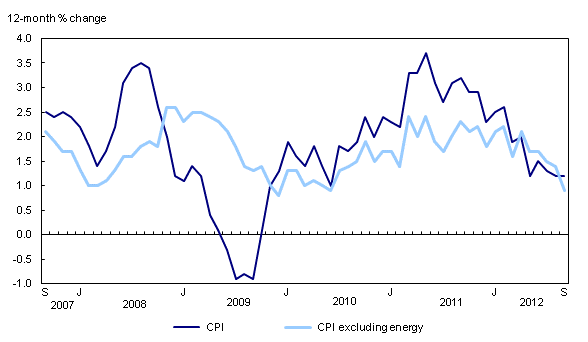
Chart description: The 12-month change in the Consumer Price Index (CPI) and CPI excluding energy
Excluding energy, the CPI rose 0.9% in the 12 months to September, after rising 1.4% in August. This slower rate of change in the CPI excluding energy indicates that energy prices were the main upward contributor to the All-items CPI in September.
12-month change in the major components
Consumer prices rose in every major component in the 12 months to September, except for clothing and footwear.
Prices rise in every major component except clothing and footwear
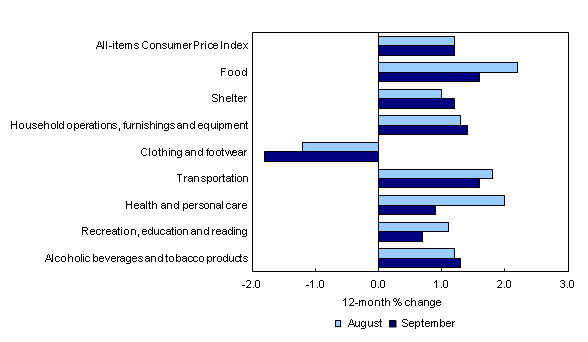
Chart description: Prices rise in every major component except clothing and footwear
Prices for transportation rose 1.6% in the 12 months to September, after rising 1.8% in August. The advance in the transportation component in September was led by higher prices for gasoline. This was tempered by lower year-over-year price increases for the purchase of passenger vehicles.
Shelter costs rose 1.2% in the 12 months to September, following a 1.0% gain in August. In addition to higher electricity prices, increases were recorded for homeowners' replacement cost and rent. Natural gas prices and mortgage interest cost declined on a year-over-year basis.
Food prices rose 1.6% in the 12 months to September, following a 2.2% increase in August. This slower year-over-year advance was attributable to monthly price decreases in September for food purchased from stores. Notable declines were recorded for fresh vegetables, fresh fruit, meat (particularly fresh or frozen pork) and cereal products.
Tuition fees rose 3.7% in September 2012. This figure reflects the recent decision to freeze tuition fees in Quebec.
12-month change in the provinces
Consumer prices in Newfoundland and Labrador, Prince Edward Island, New Brunswick, and Alberta rose at a faster year-over-year rate in September compared with August, led by higher price increases for gasoline.
Consumer prices grow at slowest rate in Ontario and British Columbia
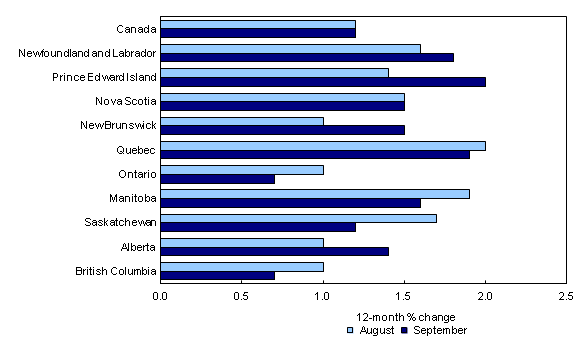
Chart description: Consumer prices grow at slowest rate in Ontario and British Columbia
Prices in Ontario and British Columbia increased the least (+0.7%) of all provinces in the 12-months to September.
In Ontario, gasoline prices advanced 3.6% in the 12 months to September after rising 0.3% in August. Despite this acceleration in gasoline prices, the year-over-year increase in the Ontario All-items CPI slowed from a 1.0% rise in August to a 0.7% increase in September. The slower pace was primarily the result of smaller monthly price gains in September 2012 compared with September 2011 for both the purchase of passenger vehicles and women's clothing.
Consumer prices in British Columbia increased 0.7% in the 12 months to September, after rising 1.0% in August. British Columbia was the only province where gasoline prices fell (-0.8%) on a year-over-year basis in September.
Seasonally adjusted monthly CPI increases
On a seasonally adjusted monthly basis, the CPI increased 0.2% in September after rising 0.4% in August.
Seasonally adjusted Consumer Price Index increases
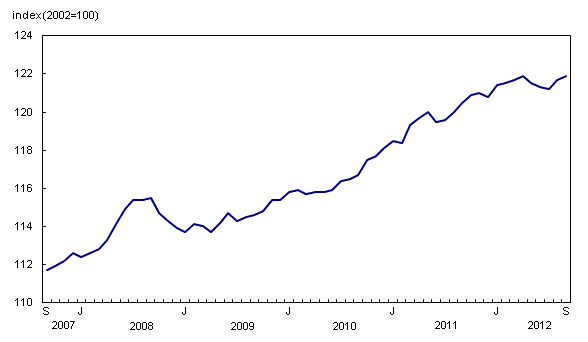
Chart description: Seasonally adjusted Consumer Price Index increases
The seasonally adjusted index for transportation rose 0.9% while the clothing and footwear index went up 0.1%. The food index fell 0.2% in September, following a 0.3% increase in August.
Bank of Canada's core index
The Bank of Canada's core index rose 1.3% in the 12 months to September, following a 1.6% increase in August. The slower rate of increase was mostly attributable to smaller price increases for the purchase of passenger vehicles.
On a monthly basis, the seasonally adjusted core index was unchanged in September after rising 0.3% in August.
Note to readers
The special aggregate "Energy" includes: electricity; natural gas; fuel oil and other fuels; gasoline; and fuel, parts and supplies for recreational vehicles.
The Bank of Canada's core index excludes eight of the Consumer Price Index's most volatile components (fruit, fruit preparations and nuts; vegetables and vegetable preparations; mortgage interest cost; natural gas; fuel oil and other fuels; gasoline; inter-city transportation; and tobacco products and smokers' supplies) as well as the effects of changes in indirect taxes on the remaining components.
A seasonally adjusted series is one from which seasonal movements have been eliminated. Users employing Consumer Price Index data for indexation purposes are advised to use the unadjusted indexes. For more information on seasonal adjustment, see Seasonal adjustment and identifying economic trends.
Available without charge in CANSIM: tables CANSIM table326-0009, CANSIM table326-0012, CANSIM table326-0015 and CANSIM table326-0020 to 326-0022.
Definitions, data sources and methods: survey number survey number2301.
For a more detailed analysis, consult the publication The Consumer Price Index. The September 2012 issue of The Consumer Price Index, Vol. 91, no. 9 (Catalogue number62-001-X, free), is now available from the Key resource module of our website under Publications.
More information about the concepts and use of the Consumer Price Index are also available online in Your Guide to the Consumer Price Index (Catalogue number62-557-X, free) from the Key resource module of our website under Publications.
The Consumer Price Index for October will be released on November 23.
For more information, or to enquire about the concepts, methods or data quality of this release, contact Statistics Canada's National Contact Centre (toll-free 1-800-263-1136; 613-951-8116; infostats@statcan.gc.ca) or Media Relations (613-951-4636; statcan.mediahotline-ligneinfomedias.statcan@canada.ca).
- Date modified:
